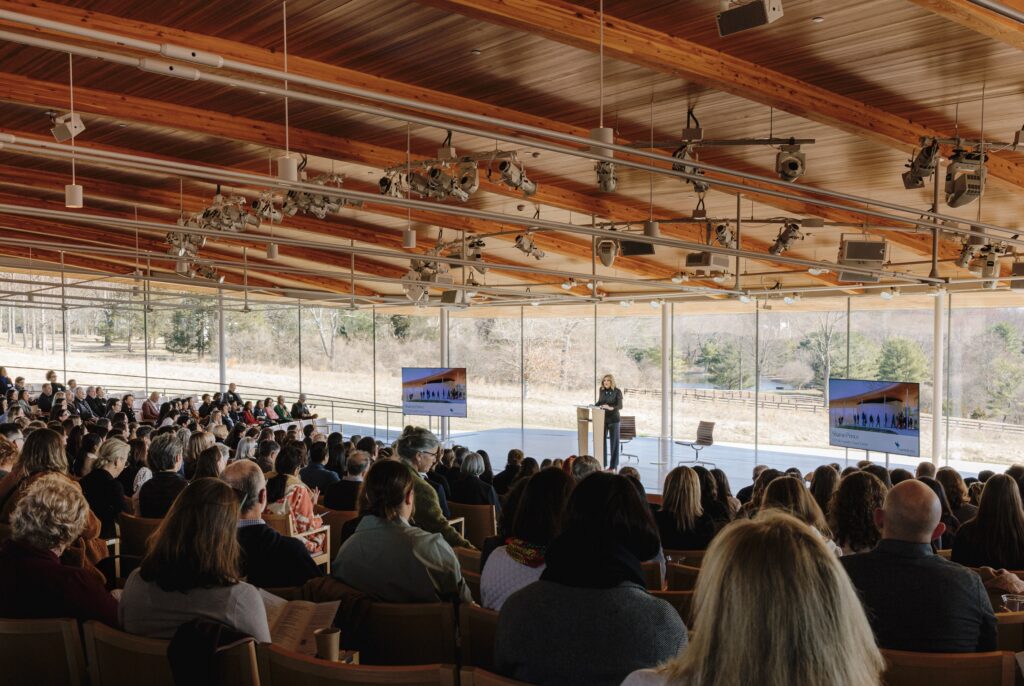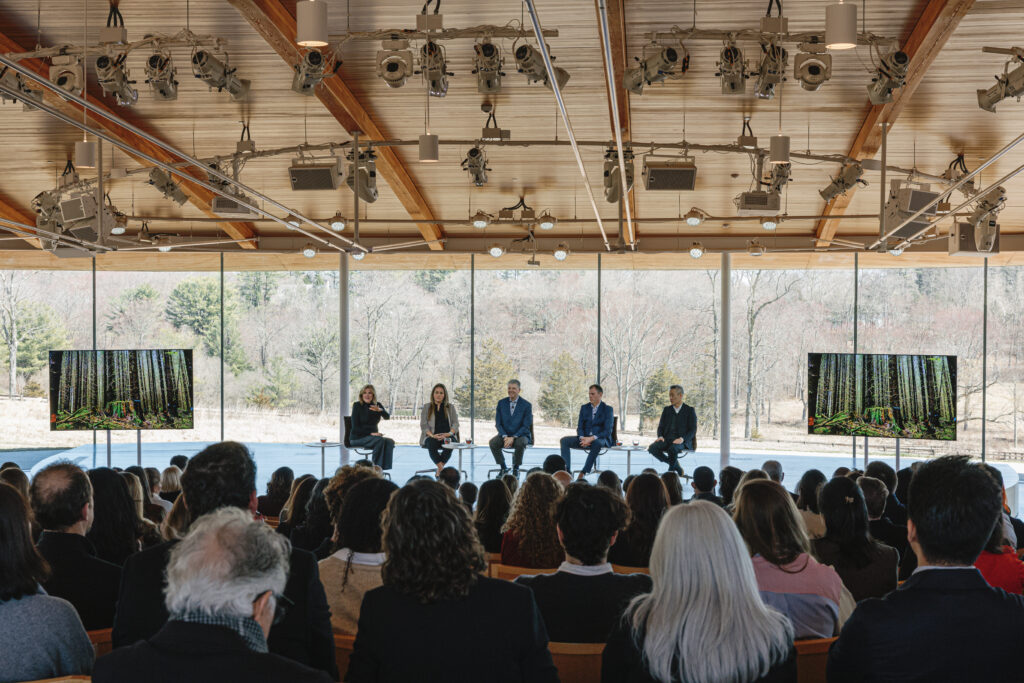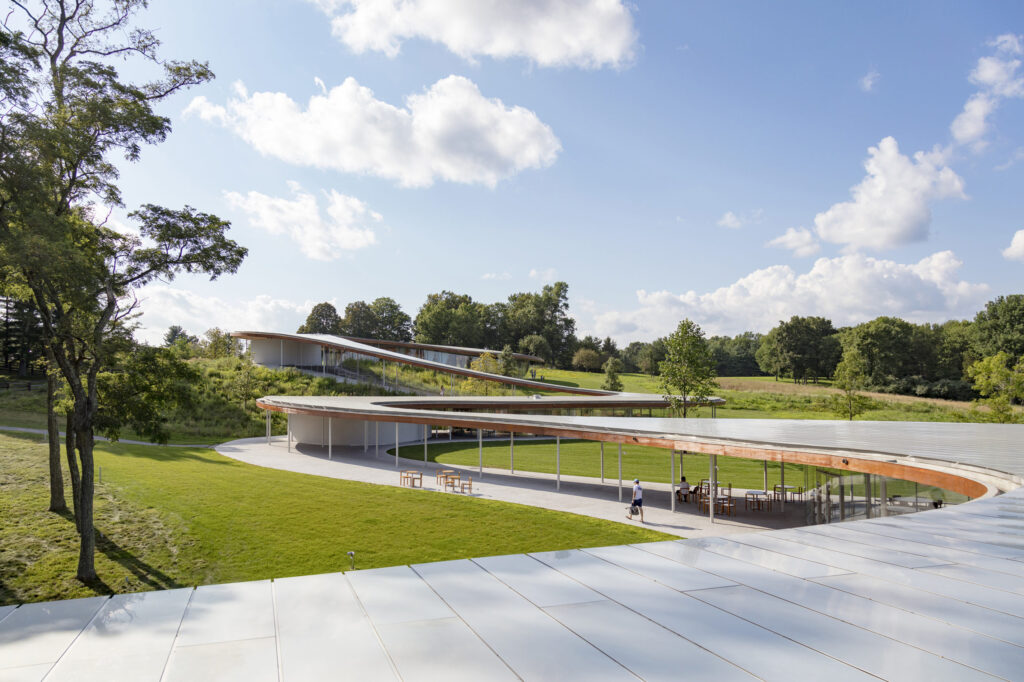This year’s Design for Freedom Summit held on March 27 continued to build on the momentum of previous years, delivering inspiration, hope, and a commitment to act on designing and building a more humane future for all. Another sold-out Summit, Grace Farms welcomed more than 550 leaders from architecture, engineering, construction, tech, government, manufacturing, nonprofits, real estate, and academic sectors to advance the movement and create true market transformation.

Sharon Prince opens the sold-out Design for Freedom Summit at Grace Farms. Photo by Melani Lust.
In addition, we also welcomed next-generation leaders from 25 universities and our Summit sponsors offered student scholarships for 75 students.
Leaders and experts across these sectors provided insights into the latest research and technology, as well as in-field actions taken that are actualizing the Design for Freedom Principles: to find and address forced labor, pursue ethical decarbonization, and prioritize circularity.
Below is the Welcome Address from Sharon Prince, CEO and Founder of Grace Farms, as well as the Founder of Design for Freedom, the global movement committed to removing forced labor from the building materials supply chain. (featured photo by Melani Lust)
Every building tells a story of humanity – either of dignity or exploitation. – Sharon Prince
______________________
Good morning, welcome to Grace Farms for our 4th Annual Design for Freedom Summit!
We are here together in this hopeful space to accelerate the Design for Freedom movement – to apply our collective expertise and leadership from across disciplines and to ultimately use our voices and purchasing power. We have an audacious mission to remove forced and child labor from the colossal building materials supply chain, which is a basic human right and a matter of right and wrong.
Every building does tells a story of humanity — either of dignity or exploitation. Today, we will explore both but will lay out a clear pathway for human dignity. We want to inhabit a world that does not accept or normalize exploitation as a means to an end.
We are creating a radical paradigm shift towards a more equitable future with a tremendous amount of rigor, determination, and hope in a time of massive disruption.
The green transition is in peril. Backlashes against gender and racial equity are on the rise. Escalating and reciprocal tariffs and duties are impacting supply chains and have created unprecedented economic uncertainty for companies across all sectors.
What is certain is that increased supply chain disruption significantly increases the risk of exploiting vulnerable populations.
Design for Freedom is not opt-in but rather has legal underpinnings, meaning that modern slavery is illegal in nearly every country at varying degrees of oversight and compliance.
We cannot accept the slavery or exploitation discount. I argue that subsidizing products with forced and child labor stymies innovation, as R&D investment dries up due to the lack of commercial viability. Solar panels offer a clear example.
We cannot accept the slavery or exploitation discount.
Coming together at this Summit could not be more timely. We must act. 28 million people are held in forced labor conditions globally. Their suffering is embedded in construction projects worldwide. And the economic scale of the construction sector is at 13% of Global GDP.
G20 countries alone import nearly $500 Billion in products that are at high risk of forced labor. Four of these top six fraught products are ubiquitous in the built environment: electronics, solar panels, textiles, and timber. Forced labor in the building materials supply chain is not a peripheral issue — it is central to how our world has been built.

Sharon Prince moderates a panel on Generational Forest Stewardship in Haida Gwaii. Photo by Melani Lust.
And yet, the disaggregated global building materials supply chain is opaque with margins that are historically thin, fueling exploitation. Up to 50% of all raw materials are used in our buildings and landscapes; for example, 38% of timber and 50% of copper production. These materials are getting a labor transparency pass.
First, food was called to be accountable to a fair-trade supply chain, then clothing; now we are calling shelter into account.
This is a significant undertaking to take on the mammoth construction sector, but it is important to note that this undertaking is also our duty — our duty of care.
We are exploring uncharted territory to consider how to assess whether our vast supply chains are inadvertently subsidizing forced or child labor.
To achieve excellence, you always start at the bottom of the next level you are trying to master.
As legendary athlete, five-time Olympian, and volleyball player Kerri Walsh Jennings noted on International Women’s Day here at Grace Farms a few weeks ago – “to achieve excellence, you always start at the bottom of the next level you are trying to master.“
I ask you to master the next level with us — to be a human rights activist and a better business, NGO, government agency, lawyer, and scholar.
The fundamentals are ‘asking’, a little ‘material obsession’, and ‘commitment to your ethical standards’.
Ask yourself first how you will use your agency. Then, boldly up the ante by asking your suppliers, owners, business partners, and universities – where are your building materials coming from, and are they made with fair labor? Expand your asks across the table.
It is paradoxical to believe that we can create beautiful, significant, essential buildings around that table for the next generation while child laborers might be the ones providing the materials — at the expense of education and generational opportunity.
The good news is that our three Design for Freedom principles — Find & Address Forced and Child Labor, Pursue Ethical Decarbonization and Prioritize Circularity — will be covered throughout the day, and you can do a deep dive into each of these and find updated tools in our newly published Design for Freedom International Guidance & Toolkit online and now in print as of today! We have a copy for you to pick up at the end of the day as a gift to place in your offices. See our smart Design for Freedom Interoperability Tech Platform Chart developed with a Design for Freedom Working Group subgroup – with all-star engineers from ARUP, Silman, Thornton Tomasetti, and others, which will speed up transparency when adding construction data. A simple assessment – use AI and tech.
The difference between last year and this year is that we have expanded public awareness and international engagement.
- We are introducing Design for Freedom to the public here at Grace Farms six days a week with the first-of-its-kind permanent With Every Fiber Exhibit in the West Barn Hall, curated by our Founding Creative Director Chelsea Thatcher, designed by Nina Cooke John with graphics by Pentagram, and assessed by Buro Happold to be neuro-inclusive as well. The London Philharmonic Orchestra recorded pieces you heard in the exhibit and were played in London at our Pilot Project, Black Chapel, the Serpentine Pavilion in 2022. We applied our Design for Freedom principles with many firms and the Yale Center for Ecosystems + Architecture created the biomaterial wall that is featured. We have not only used circularity in the materials but also the entire With Every Fiber exhibit is circular. We will be introducing new materials and features in the next version, which will open in October on our 10th anniversary!
- Our Grace Farms Teas & Coffees are accelerating public access at Whole Foods and corporate offices, which you will hear more about this morning from Adam.
- Internationally, we have added substantial capacity and partnerships in short order. We are on a mission where time does matter to millions of people today.
Yumiko Yamada, partner at SANAA and President of AIA Japan, who is here today, invited me to share Design for Freedom with Kazuyo Sejima-san at the International House of Japan for the first time in two languages. I found the duty of care and reverence for nature and materials like timber to already be high.
Today, you will hear from The Right Honorable Baroness Lola Young, Parliamentarian and Chancellor of Nottingham University, who wrote an opening for our newly released Guidance & Toolkit. Yesterday, (March 26), we launched our new Design for Freedom Podcast!
You should also know that every speaker you will hear from today is adding their agency to Design for Freedom in some fashion. Most likely, you will learn that they have been at it with us for years.
Since today’s gathering is a Summit, not a Conference, it’s critical that you know who the leaders are in this room with you.
We have next-generation leaders from 25 universities. You are the generation that flat-out does expect responsible sourcing! Prof. Patricia Saldana Natke has again brought 20 IIT and University of Illinois Urbana-Champagne students from a studio class that she has taught over the past five years! Back in 2019, she said, “We have to get this information in classes and to more students.” And she figured out how to do that nearly immediately.
The incoming AIA President, Ilya Azaroff, has brought over a dozen students from New York City Tech. Dr. Sarah Billington of Stanford University’s Civil & Environmental Engineering School is applying scientific methods to determine the labor fingerprint in concrete — something that has never been done before. University of Virginia faculty and leadership are also here to share their incredibly aligned Design for Freedom Pilot Project, The Karsh Institute of Democracy.
We are grateful to our seven Summit sponsors who offered student scholarships so 75 of you could attend today. Our three Lead Sponsors have each contributed to the Design for Freedom movement in a range of actionable ways:
- Assa Abloy
- The president and head of US Commercial Sales references Assa Abloy’s efforts with Design for Freedom as an imperative for all functions across the organization, which has 60,000 employees.
- They have 19 people across disciplines in attendance today!
- Acelab
- Acelab is a new technology platform that is integrating the Design for Freedom ethical material evaluation guidelines into the Materials Hub, which empowers Architecture & Design firms to research, select, and document material decisions. Vardhan, you made a commitment to integrate Design for Freedom into your platform about four years ago when you were in start-up mode!
- MillerKnoll
- MillerKnoll was also an early adopter, helping to set up our first Design for Freedom Pilot Project, the New Canaan Library with Turner Construction. And they also provided all the traced textiles for our With Every Fiber Exhibit.
More pro-bono work is happening nonstop. Recently, a subgroup of top structural engineering firms formed to add Design for Freedom to their means and methods. About 40 Design for Freedom Working Group members are here today with even more from their firms, nine ASCA Distinguished Architects and Ph.D. students are Design for Freedom jurors, five industry association CEOs and Founders are here today with whom we collaborate. There’s a lot happening….!
Each year, we also invite Global Human Rights Defenders who are also committed to the arts being a powerful tool for Grace and Peace.
- At our first Summit three years ago, with the pandemic still nipping at our heels, Prince Zeid Ra’ad Al Hussein, former High Commissioner on Human Rights and CEO of IPI, International Peace Institute.
- Last night, we partnered with IPI for an Art for Peace event. Nasreen Sheik and Chelsea Thatcher spoke about Building a Culture of Peace and Reconciliation through Art with Zeid. Last year, I told Nasreen that we are indeed committed to expanding the Peace Table. Nasreen is here today to share her work as a global human rights leader and social entrepreneur.
- Hugh Evans, whom I also greatly admire, will give us a tremendous boost at the close of the day, reminding us that when we use our voices together, we are powerful and can ensure lasting change. He is a leading international humanitarian who collaborates with artists like Chris Martin and Beyonce and regularly meets with world leaders. He is Founder of Global Citizen, a movement that inspires actions by the millions to End Extreme Poverty, Defend the Planet and Demand Equity. Just you wait…

Hugh Evans gives closing remarks. Photo by Melani Lust.
In the face of such an overwhelming and complex humanitarian crisis, it would be easy to feel powerless, to delay, to not do the right thing.
Our work is compounding at a rapid rate.
In the face of such an overwhelming and complex humanitarian crisis, it would be easy to feel powerless, to delay, to not do the right thing. But that is precisely why we are here—because we refuse to accept that these conditions are inevitable. Modern slavery will not reverse on its own. It requires intervention. Today.
As we begin this Summit, I invite you to bring all you can to this work and to become a little more obsessed with the human-made materials that sit on this earth. The challenges are great, but so too is our collective resolve. Listen actively, engage thoughtfully, and commit.
Thank you for being here. Thank you for your commitment. And now, let us continue this important work together. It is now my honor to introduce, with great admiration, Grace Forrest and Amar Lal.

(l-r:) Grace Forrest and Amar Lal during the Summit’s Opening Conversation in the Sanctuary. Photo by Melani Lust.
Grace has dedicated her career to ending modern slavery and human trafficking worldwide. Through Walk Free’s groundbreaking research and advocacy, including the seminal Global Slavery Index, Grace has helped elevate the issue of modern slavery to the global stage and mobilized action across governments, businesses, and civil society. One of the most respected voices in the fight against forced and child labor, Grace gives us hope.
Amar gives us hope—as to what is possible. He is a powerful child rights activist whose lived debt bondage experience in stone quarries informs his extraordinary work. As a lawyer and advocate, he is a tireless champion for exploited children.
Welcome to you both!
______________________
About Grace Farms Foundation

The River building at Grace Farms is embedded in nature. Nearly 80 acres of natural and diverse landscapes surround the award-winning River. (photo by Sahar Coston-Hardy)
We bring together people across sectors to explore nature, arts, justice, community, and faith at the SANAA-designed River building and Barns, on 80 acres of publicly accessible natural landscape.
Our humanitarian work to end modern slavery and foster more grace and peace in our local and global community includes leading the Design for Freedom movement to eliminate forced labor in the building materials supply chain.
This collaborative approach to comprehensively address humanitarian issues and generate new outcomes is reflected across all of our initiatives and the place of Grace Farms.
Membership
Grace Farms members can visit without advance registration and enjoy a 20% discount on paid programs, retail, and dining, invitations to members-only gatherings, complimentary events, and a welcome gift from Grace Farms Tea & Coffee.
Becoming a member helps us advance our mission to pursue a more peaceful world and supports the preservation of the River building and its surrounding 80 acres.
For more information, visit gracefarms.org/membership.
Visit our calendar of events to learn more about upcoming programs.
Sign-up for our newsletter
Follow us
@gracefarmsct #gracefarms

